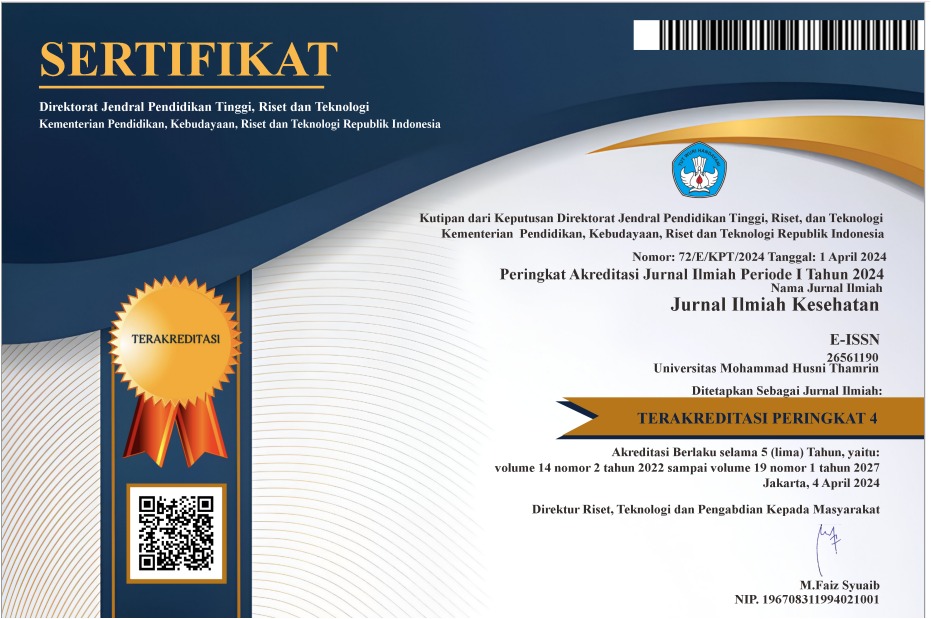PENGARUH BERAT LAHIR MENURUT USIA KEHAMILAN TERHADAP KELANGSUNGAN HIDUP BAYI DI INDONESIA
DOI:
https://doi.org/10.37012/jik.v15i1.892Abstract
Infant survival is defined as the ability of infants to survive through life until the age of 1 year. In 2012, Indonesia IMR reportedd as 32 per 1,000 live births. Sosio economic status will affect infant survival through maternal factors, nutrition, fetal condition at birth, disease control and environment. This study aims to determine the effect of birth weight for gestational age on the infant’s survival in Indonesia. The Method of study is a retrospective cohort, utilize of data 13 295 child data contained in the Riskesdas data 2013. Result of the analysis showed that the survival of small for gestational age had the lowest probability of 97%. Results cox regression showed that small for gestational age on the high economic status, HR = 8.95, the middle-income status, HR = 3.72, and the poor economic status, HR = 7.36. Small for gestational age have contributed to infant mortality in the population by 42%. Improving the quality of antenatal care for during pregnancy and socialization of kangaroo care method for birth weight small for gestational age is an alternative to decrease the incidence of small for gestational age.
Â
Keywords:Â infant survival, small for gestational age, economic status
References
Atmarita. (2004). Analisis Situasi Gizi dan Kesehatan Masyarakat. Jakarta.
Balitbangkes RI. (2013). Riset Kesehatan Dasar. Jakarta: Badan Penelitian dan Pengembangan Kesehatan Kementrian Kesehatan RI.
BPS. (2013.). Indonesia Demographic and Health Survey 2012. . Jakarta: ICF International 2013.
Chen, X.-K., Wen, S. W., Fleming, N., Demissie, K., Rhoads, G. G., & Walker, M. (2007). Teenage Pregnancy and Adverse Birth Outcomes: A Large Population Based Retrospective Cohort Study. International Journal of Epidemiology, 36.
Djaja, S., Hapsari, D., Sulistyowati, N., & Lolong, D. B. (2009). Peran Faktor Sosio-Ekonomi, Biologi dan Pelayanan Kesehatan terhadap Kesakitan dan Kematian Neonatal. Majalah Kedokteran Indonesia, 59.
Hong, R., & Beltran, M. R. (2008). Low Birth Weight as A Risk Faktor for Infant Mortality In Egypt. Eastern Mediterranean Health Journal, 14.
Katz, J., Jr, K. P. W., Khatry, S. K., Christian, P., Clerq, S. C. L., Pradhan, E. K., & Shrestha, S. R. (2003). Risk Factors for Early Infant Mortality in Sarlahi District, Nepal. Buletin of The World Health Organization, 81(10).
Kementrian Kesehatan Republik Indonesia. (2014). Profil Kesehatan Indonesia Tahun 2013. Jakarta: Katalog dalam Terbitan.
Kementrian Kesehatan RI. (2014). Buku Pedoman Pengenalan Tanda Bahaya pada Kehamilan, Persalinan dan Nifas. Jakarta.
Kemkes. (2010). Pelayanan Antenatal Terpadu. Jakarta: Dirjen Bina Kesehatan Ibu dan Anak.
Kemkes. (2013). Pelayanan Kesehatan Ibu di Fasilitas Kesehatan Dasar dan Rujukan. Jakarta: Kementrian Kesehatan RI.
Lee, H. C., Ramachandran, P., & Madan, A. (2010). Morbidity Risk at Birth for Asian Indian Small for Gestational Age Infant. American Journal of Public Health, 100.
Mosley, W. H., & Chen, L. C. (1984). An Analytical Framework For The Study Of Health Survival In Developing Countries. Buletin of The World Health Organization.
Mosley, W. H., & Chen, L. C. (2003). An Analytical Framework for the Study On Child Survival In Developing Countries. Bulletin of the World Health Organization, 81.
Nimi, T., Fraga, S., Costa, D., Campos, P., & Barros, H. (2016). Prenatal Care and Pregnancy Outcomes: A Cross-sectional Study in Luanda, Angola. International Journal of Gynecology and Obstetrics, 135.
Nurmaiti, & Besral. (2008). Pengaruh Durasi Pemberian ASI terhadap Ketahanan Hidup Bayi Indonesia. Jurnal Makara, Vol 12, 47-52.
Oakley, L., Maconochie, N., & Doyle, P. (2009). Mulivariate Analysis of Infant Death in England and Wales In 2005-2006 With Fokus on Socio-Economic Status and Deprevation. Health Statistics Quarterly, 42.
Ota, E., Haruna, M., Suzuki, M., Anh, D. D., Tho, L. H., Tam, N. T. T., . . . Yanai, H. (2010). Maternal Body Mass Index and Gestational Weight Gain and Their Assosiation with Perinatal Outcomes in Viet Nam. Bulletin of the World Health Organization, 89.
Permendagri. (2010). Lampiran 1: Peraturan Menteri dalam Negeri. Stat 54 (2010).
Saifuddin, A. B. (2007a). Buku Acuan Nasional Pelayanan Kesehatan Maternal, dan Neonatal Edisi Pertama Cetakan Ketiga. Jakarta: Yayasan Bina Pustaka Sarwono Prawirohardjo.
Saifuddin, A. B. (2007b). Buku Acuan Neonatal Pelayanan Kesehatan Maternal dan Neonatal. Jakarta: Yayasan Bina Pustaka Sarwono Prawirohardjo.
Salihu, H. M., August, E. M., Cruz, C. d. l., Mogos, M. F., Weldeselasse, H., & Alio, A. P. (2013). Infant Mortality and the Risk of Small Size for Gestational Age in the Subsequent Pregnancy: A Retrospective Cohort Study. Matern Child Health Journal, 17.
Samra, N. M., Taweel, A. E., & Cadwell, K. (2013). Effect of Intermittent Kangaroo Mother Care on Weight Gain of Low Birth Weight Neonates With Delayed Weight Gain. The Journal of Perinatology Education, 22.
Sochet, A. A., Ayers, M., Quezada, E., Braley, K., Leshko, J., Amankwah, E. K., . . . Dadlani, G. (2013). The Important of Small for Gestational Age in the Risk Assement of Infant With Critical Congenital Heart Disease. Cardiology in the Young, 23.
Sungkar, A. (2015) The Etiology and Prevention Strategy of Small for Gestational Age from Obstetrician View. Jakarta.
Surasmi, A., Handayani, S., & Kusuma, H. N. (2002). Perawatan Bayi Risiko Tinggi. Jakarta: EGC.
Wennerström, E. C. M., Simonsen, J., & Melbye, M. (2015). Long-Term Survival of Individuals Born Small and Large for Gestational Age. Plos One Journal, 10.
WHO. (2005). Health And the Millennium Development Goals. France.
WHO. (2006a). Pregnancy, Childbirth, Postpartum and Newborn Care: A Guide for Essential Care. Geneva: WHO.
WHO. (2006b). The World Health Organization Growth Standart.
WHO. (2014a). Infant Mortality Data by WHO Region World Health Organitation.
WHO. (2014b). Infant Mortality situation and trends. Retrieved 31 Maret 2016
Wigati, T. R. (2009). Fenomena Gizi Buruk pada Keluarga dengan Status Ekonomi Baik: Sebuah Studi tentang Negative Deviance di Indonesia. The Indonesian Journal of Public Health, 5 89-93.
Downloads
Published
How to Cite
Issue
Section
Citation Check
License
Jurnal Ilmiah Kesehatan allows readers to read, download, copy, distribute, print, search, or link to the full texts of its articles and allow readers to use them for any other lawful purpose. The journal allows the author(s) to hold the copyright without restrictions. Finally, the journal allows the author(s) to retain publishing rights without restrictions Authors are allowed to archive their submitted article in an open access repository Authors are allowed to archive the final published article in an open access repository with an acknowledgment of its initial publication in this journal.

Lisensi Creative Commons Atribusi 4.0 Internasional.










